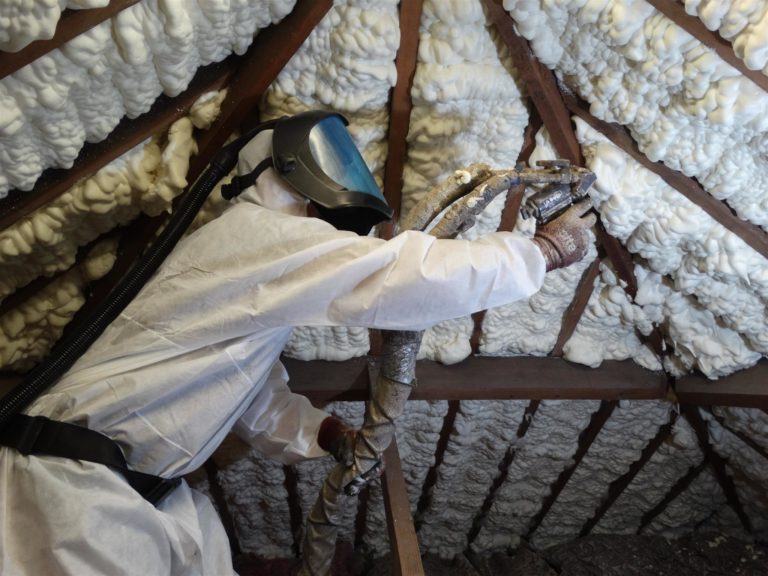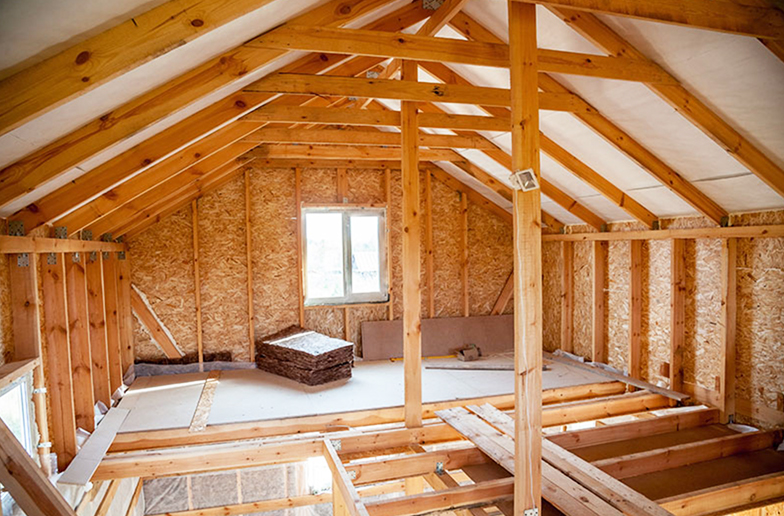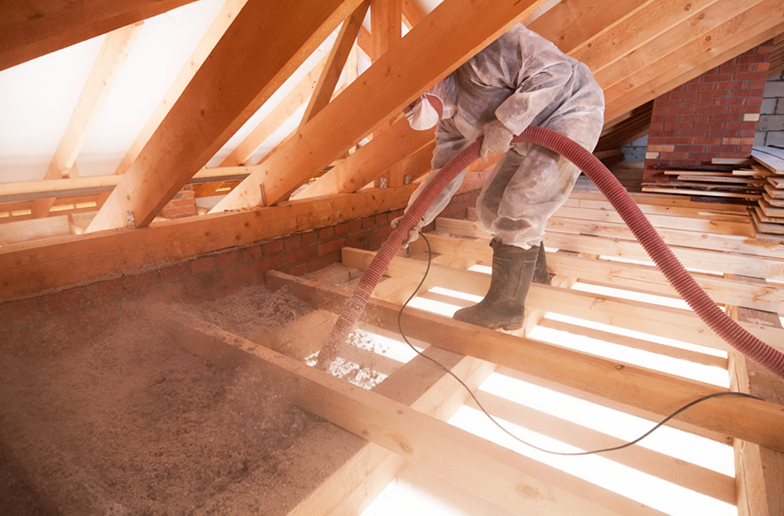With so many types of loft insulations in the market, which one is best for your home? We’re here to help you make the right decision. The video below shows a display that mimics the heat source that’s installed in your home. It pushes warm air into three different types of loft insulation to show you how much air can flow through them. Watch the video below.

If you have a loft then you definitely need the best loft insulation in the market. A quarter of heat is lost through the roof in an uninsulated home. Insulating your loft, attic or flat roof is a simple and effective way to reduce heat loss and reduce your heating bills.
The problem is there are many different options for insulation. In this post, we’ll explore the different types of loft insulation and which is most effective.
With the right approach, you will need a specialist to insulate your roof.
This is not a DIY job.
Table of Contents
Types of Loft Insulation to Choose from :
If your loft is easy to access and has no damp or condensation problems, it should be easy to insulate. With winter around the corner, we’re all turning up our heating to make sure we don’t freeze at home.
This can get expensive if you’re losing a lot of heat through the roof, but insulating your loft the right way will pay for itself in no time.
1.1 – Spray Foam Insulation

Spray Foam Insulation is a superior product compared to all other types of loft insulation. When sprayed at rafter level, it seals the home creating an air-tight warm roof structure which contributes to keeping your home warm in winter, cool in summer whilst lowering heating and cooling costs by up to 50%, which can’t be achieved with traditional insulation!
Spray foam insulation once applied, expands to roughly 100 times its original volume and as a result fills every crack and crevice to eliminate air leakage or infiltration.
To be honest spray foam loft insulation costs considerably more than traditional insulation, but it is the most superior form of insulation on the market today. I’m sure you would agree that the cheapest solutions can end up being your most expensive mistakes.
As well as insulating the roof, we do recommend the gables to be included to maximise efficiency.
Check out out why people choose Evergreen’s Icynene spray foam loft insulation. Visit page here.
PROS :
1.Eco Friendly: Spray foam insulation is an ecofriendly product and reduces your carbon footprint.
2.100% Water Blown: Icynene foam insulation Spray is 100% water blown with no harmful
chemical blowing agents.
3.Breathable insulation: Icynene open cell insulation allows the timbers to breathe, which
also prevents moulding and condensation.
5.Reduces Noise Pollution: Icynene Spray foam insulation minimises airborne sounds.
6.Fills all gaps: Spray foam insulation is ideal for roofs, walls, lofts, underfloor and attics.
7.Energy Saving: Helps in saving up to* 50% on your energy bills.
CONS:
1.Not a DIY product: Icynene Spray foam insulation can only be installed by a licensed accredited installer,
you cannot do it from a local store.
2.Not the cheapest Solution: Not the cheapest Solution: Spray foam insulation costs more than traditional insulation methods on the market. Spray foam is not the cheapest insulation solution, but it’s the most superior form of insulation on the market today.
1.2 – Fiberglass (Traditional Insulation)

The transfer of heat is slowed down with fiberglass insulation because the glass fibers trap air bubbles. These bubbles create an insulating effect by slowing heat exchange between areas and surfaces.
Fiberglass insulation usually comes in batts or rolls. In order to be completely effective, fiberglass insulation must be cut carefully around obstacles such as power sockets. This can be incredibly time consuming.
Fiberglass insulation is significantly cheaper than spray foam insulation, but it is also less effective, especially in winter. Fiberglass is the most common type of loft insulation, however, is outdated and has to be topped up every 5 years because it deteriorates through condensation issues.
Warning: The tiny fibers of glass from fiberglass insulation can irritate your skin and eyes. If you experience too much contact with fiberglass, it can cause what’s called irritant contact dermatitis, or inflammation of the skin. Breathing in fibers can also increase the difficulty of breathing according to HowStuffWorks.
Professional installation is required for spray foam insulation, where as fiberglass insulation can often be installed by homeowners themselves.
PROS:
1.Fibreglass insulation does not burn
2.Fibreglass insulation is available in High and Medium density options
3.Fibreglass insulation is inexpensive
4.Fibreglass or Glasswool insulation forms a protective vapour barrier.
CONS:
1.Fibreglass insulation starts SAGGING as time passes
2.Causes Skin irritation: The installers must wear protective wear when installing fibreglass to protect themselves from the “silver” released from Fibreglass.These silvers if inhaled will lead to skin and respiratory disease.
3.Harmful chemicals: Glasswool contains harmful chemicals like Formaldehyde which is
highly toxic.
1.3 – Cellulose (Traditional Insulation)

Cellulose insulation includes cellulose cells that have natural insulating power. It is made of shredded paper plus a fire retardant chemical known as a borate. The paper is broken down into cellular fibers that provide insulation.
Cellulose insulation in installed into your loft using an insulation blower. The fibers flow through a long hose and are blown / sprayed into your loft space. The blown cellulose is prone to create dust that is blown into the holes or inadequate seals around fixtures. This is a health hazard.
Cellulose is more energy efficient than fiberglass spray foam insulation and does have better sound insulation but is still incomparable to spray foam insulation.
Both cellulose insulation and fiberglass insulation are low cost and have a similar price per sqm. However, as cellulose insulation often requires professional installation and specialised skills, it usually turns out to be more expensive.
PROS:
1.Ecofriendly product: Cellulose insulation is made from newspapers and therefore it is ecofriendly
2.Not an Expensive product: Cellulose insulation is the cheapest of all the insulation methods.
3.Energy Efficient: Cellulose is more energy efficient than fiberglass insulation.
CONS:
1.Moulding and Rotting: The efficiency of Cellulose decreases due to the insulation absorbing moisture and this causes moulding and rotting.
2.Sagging: Loose fill(Cellulose) saggs as time passes and this results in the decrease of performance.
3.Health Hazard: The blown cellulose is prone to create dust that is blown into the holes or inadequate
seals around fixtures.
Spray Foam Loft Insulation Compared to Traditional Insulation:

The truth is fibreglass insulation allows air very slowly to pass through the small gaps which can create heat loss in the property increasing your energy prices, let’s not mention that you have to replace it every 5 years. Whereas spray foam insulation creates an air barrier to prevent air from escaping and cold air from entering and it comes with a 25 years manufacturers warranty.
Still not convinced? For more information on the difference between spray foam insulation & traditional insulation visit the page here.
How much does it cost to Insulate a loft in the UK?
Investing in loft insulation can be a difficult decision, there are so many options to choose from, and some forms of insulation will benefit your home far more than others. Due to this, we have written this guide that explains the positives and negatives of each type of loft insulation, so you can decide on the best type of insulation for your home.
Before we start, let’s look at what loft insulation is and why it is something that you should be thinking about installing if you do not already have it.
What is loft insulation?

Loft insulation is the practice of filling your attic space with insulation material to reduce the amount of heat that escapes from your home to the outside. In the UK, the loft is what we tend to call the space at the top of the house, or the attic. While there is an initial expense for insulation, you will recoup the amount you’ve spent through reduced energy bills, and you will also have helped the environment by not wasting energy. This makes it a worthwhile investment for any property that does not have loft insulation
Loft insulation comes in a variety of forms, and the type you choose will have an impact on how much it will cost you and how well insulated your house is.
Blanket loft insulation
The first type of loft insulation is called blanket loft insulation. This is typically used by people who are looking for inexpensive loft insulation. It is extremely common and may be created from a variety of materials, including rocks, mineral fibre, glass, and rolls of foil-backed felt.
It is, however, recommended that you get an expert to install it to make sure it is done correctly. Not only that, but as we have already discussed, blanket insulation is made of materials such as glass, mineral fiber, and other similar materials. Each of these materials has a different price tag. Price per roll of blanket loft insulation will vary based on the type of material you choose to have installed in your attic space
The pros of blanket loft insulation
- Installation is simple
- Materials are generally free of irritants
- Reduces the amount of money spent on energy.
- Soundproofing qualities
Negatives of blanket loft insulation
- Deteriorates over time
- Doesn’t fit in small spaces/ nooks and crannies
- Materials can be irritants
Loose-fill insulation
Another approach to retaining heat in your home is via usingloose-fill insulation.
Loose-fill insulation, as opposed to blanket insulation, makes use of loose, lightweight materials such as cork grains, cellulose fiber, and mineral wool. In order to insulate the loft as equally as possible, these lightweight materials are placed in various locations around the space. If you are particularly passionate about recycling, you can even use old newspapers!
It is an appealing option because it can reach all of the difficult-to-reach areas in your loft and can be built fast and easily. Having said that, it does have a few drawbacks to consider.
For starters, it can create quite a commotion throughout the installation process. Second, loose-fill insulation has the potential to be unstable and to come free (especially in a draughty loft)
The pros of loose-fill insulation
- It is suitable for usage in any loft space.
- It can reach locations that are difficult to reach.
- Installing it takes less time as no cutting or measuring is required.
- It can be used on its own or in conjunction with other insulation materials.
- Loft insulation can be accomplished at a reasonable cost.
The negatives of loose-fill insulation
- Easily becomes loose
- Need protective gear to install it
- Can create a lot of mess and dust during installation
- R-Value decreases over time
- Risk to the structure of a property and ineffective as absorbs water
Sheet loft insulation
Sheet loft insulation is a type of insulation that is used to insulate the sloped sides of a loft, which is something that some other methods are not as good at. This entails installing insulated boards across the joists in the loft that are custom-made to fit the space.
It is available in fire and moisture-resistant varieties, and it is simple to decorate over, and that it can be installed in difficult-to-reach areas. However, it is also the most expensive. Pricing will be determined by the size of your home, how thick your sheeting is, and the sizes that you need however it is more expensive than some other superior forms of insulation.
The pros of sheet loft insulation
- Safer due to their fire and moisture resistant properties
- Can be decorated
The negatives of sheet loft insulation
- Expensive
- Uses large amounts of energy to make the sheets
- Not environmentally friendly
Blow In-Fiber insulation

Finally, there is the blown-in fibre insulation to consider.
This approach is quite similar to the loose-fill insulation method, and it is widely used to insulate the loft using materials like fiberglass and cellulose, among others. As the name says, this sort of insulation must be blown in, which means you will almost certainly need to hire a professional to complete the work. This can be a significant financial burden.
Pros of Blow In-Fiber Insulation
- Efficiently fills gaps.
- Blown-in fiberglass is considered flame resistant.
- Most blown-in cellulose materials are non-toxic.
The Negatives of Blow-In Fiber Insulation
- Requires professional installation.
- Very messy.
- Can cause ceiling sag.
- Damp blown-in insulation can promote fungal growth.
- Very problematic when wet.





